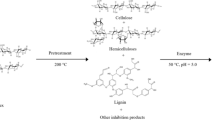Abstract
The pretreatment of lignocellulosic materials prior to the enzymatic hydrolysis is essential to the sugar yield and bioethanol production. Dilute acid hydrolysis of black spruce softwood chip was performed in a continuous high temperature reactor followed with steam explosion and mechanical refining. The acid-soaked wood chips were pretreated under different feeding rates (60 and 92 kg/h), cooking screw rotation speeds (7.2 and 14.4 rpm), and steam pressures (12 and 15 bar). The enzymatic hydrolysis was carried out on the acid-insoluble fraction of pretreated material. At lower feeding rate, the pretreatment at low steam pressure and short retention time favored the recovery of hemicellulose. The pretreatment at high steam pressure and longer retention time recovered less hemicellulose but improved the enzymatic accessibility. As a result, the overall sugar yields became similar no matter what levels of the retention time or steam pressure. Comparing with lower feeding rate, higher feeding rate resulted in consistently higher glucose yield in both liquid fraction after pretreatment and that released after enzymatic hydrolysis.





Similar content being viewed by others
References
Mabee, W. E., & Saddler, J. N. (2009). Bioresource Technology. doi:10.1016/j.biortech.2009.10.098.
Schell, D. J., Torget, R., Power, A., Walter, P. J., Grohmann, K., & Hinman, N. D. (1991). Applied Biochemistry and Biotechnology, 28–29, 87–97.
Clark, T. A., & Mackie, K. L. (1987). Journal of Wood Chemistry and Technology, 7, 373–403.
Clark, T. A., Mackie, K. L., Dare, P. H., & McDonald, A. G. (1989). Journal of Wood Chemistry and Technology, 9, 135–166.
Overend, R. P., & Chornet, E. (1987). Philosophical Transactions of the Royal Society of London, A321, 523–536.
Zimbardi, F., Viggiano, D., Nanna, F., Demichele, M., Cuna, D., & Cardinale, G. (1999). Applied Biochemistry and Biotechnology, 77–79, 117–125.
Cullis, I. F., Saddle, J. H., & Mansfield, S. D. (2004). Biotechnology and Bioengineering, 85, 413–421.
Kim, K. H., Tucker, M. P., & Nguyen, Q. A. (2002). Biotechnology Progress, 18, 489–494.
Boussaid, A. L., Esteghlalian, A. R., Gregg, D. J., Lee, K. H., & Saddler, J. N. (2000). Applied Biochemistry and Biotechnology, 84–6, 693–705.
Mackie, K. L., Brownell, H. H., West, K. L., & Saddler, J. N. (1985). Journal of Wood Chemistry and Technology, 5, 405–425.
Varge, E., Réczey, K., & Zacchi, G. (2004). Applied Biochemistry and Biotechnology, 113–116, 509–523.
David, A., Sievers, D. A., Elander, R. T., Kuhn, E. M., Nagle, N. J., Tucker, M. P. et al. (2009) NREL Report No. PO-510-45809.
Jeferson, T., & Melo, A. (2002). Polymer Engineering and Science, 42, 170–181.
Hu, G. H., & And Kadri, I. (1999). Polymer Engineering and Science, 39, 930–939.
Carneiro, O. S., Covas, J. A., Ferreira, J. A., & Cerqueira, M. F. (2004). Polymer Testing, 23, 925–937.
Zhang, X. M., Xu, Z. B., Feng, L. F., et al. (2002). Polymer Engineering and Science, 46, 510–519.
Zheng, Y., Pan, A., Zhang, R., & Labavitch, J. M. (2007). Applied Biochemistry and Biotechnology, 136–140, 423–436.
Galbe, M., & Zacchi, G. (2002). Applied Microbiology and Biotechnology, 59, 618–628.
Wu, M., Chang, K., Gregg, D. J., Boussaid, A., Beatson, R. P., & Saddler, J. N. (1999). Applied Biochemistry and Biotechnology, 77–79, 47–54.
Tengborg, C., Stenberg, K., Galbe, M., Zacchi, G., Larsson, S., Palmqvist, E., et al. (1998). Appl Biochem. Biotech, 70–72, 3–15.
Nguyen, Q. A., Tucker, M. P., Keller, F. A., & Eddy, F. P. (2000). Applied Biochemistry and Biotechnology, 84–86, 561–576.
Acknowledgements
This work was funded by the ABIP program under the network of CBioN and FQRNT. The authors would like to thank Sylvie Renaud of Pulp and Paper Division, FPInnovations for her assistance with the sugar component analysis.
Author information
Authors and Affiliations
Corresponding author
Rights and permissions
About this article
Cite this article
Fang, H., Deng, J. & Zhang, T. Dilute Acid Pretreatment of Black Spruce Using Continuous Steam Explosion System. Appl Biochem Biotechnol 163, 547–557 (2011). https://doi.org/10.1007/s12010-010-9061-6
Received:
Accepted:
Published:
Issue Date:
DOI: https://doi.org/10.1007/s12010-010-9061-6




